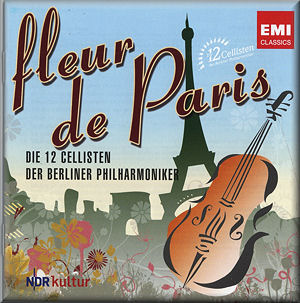 |
 |
|


alternatively
CD:
MDT
AmazonUK
AmazonUS
|
Fleur de Paris
Vincent Baptiste SCOTTO (1876-1952)
Sous les ponts de Paris [2:41]
Gabriel FAURÉ (1845-1922)
Pavane [6:10]
Georges KONYN (1894-1975)
Pigalle [3:28]
Charles TRENET (1913-2001)
Que reste-t-il de nos amours? [3:45]
Maurice RAVEL (1875-1937)
Pavane pour une infante défunte [6:17]
Michel LEGRAND (b.1932)
Une femme est une femme [2:47]
Maurice VANDAIR (1905-1982)
Fleur de Paris [2:48]
Claude DEBUSSY (1862-1918)
Clair de lune [4:38]
Marcel LOUIGUY (1916-1991)
La Vie en rose [5:06]
Hubert Yves GIRAUD (b.1920)
Sous le ciel de Paris [4:02]
Erik SATIE (1866-1925)
Gymnopédie No 1 [3:41]
Francis POULENC (1899-1963)
Figure humaine [17:27]
(arrangements: David Riniker [Konyn, Trenet, Poulenc], Michael Tsygutkin [Legrand], Ludwig Quandt [Vandair], Wilhelm Kaiser-Lindemann [all others])
 The 12 Cellists of the Berlin Philharmonic
The 12 Cellists of the Berlin Philharmonic
rec. 2-4 January 2010, Jesus-Christus-Kirche, Berlin; 22 August 2009, live, Christkirche, Rendsburg, Germany.
 EMI CLASSICS 6 08501 2 [63:46]
EMI CLASSICS 6 08501 2 [63:46] 
|
|
|
Having already conquered the pop hits of several other nations, the Berlin Philharmonic cello brigade is invading France. I’m sorry; let me try that again. The cellists of the Berlin Philharmonic, always looking for new territory to cover, march with this album triumphantly down the Champs-Élysées. I apologize. Something about the dual-language title of this disc, Fleur de Paris: Die 12 Cellisten der Berliner Philharmoniker, gets me thinking about Basil Fawlty and his injunction not to “mention the war.” Avoiding that temptation is the hard part of writing this review. The easy part is recommending this CD.
Fleur de Paris is, in truth, a lot of fun. The Berlin Philharmonic’s cello players really do love this music, and they play it with sensitivity, grace, humor, and the sort of perfumed elegance which Basil Fawlty’s jokes implied the Germans could never have in such quantities. Just listen to the rocking lilt of the waltz “Pigalle,” the main tune flowing alongside a series of rhapsodic accompanying solos. It’s a moment begging to be set to a black-and-white film scene, with dancers whirling around a ballroom slightly smoky from cigars, the men staring deeply into their partners’ eyes, the steps of the waltz transporting the couples into their own worlds.
There’s a well-judged mix of classical and pop tunes here. Ravel’s Pavane gets a loving caress, in a beautiful arrangement which gives the main tune, on its reprise (2:17) to multiple cellos singing the theme in different octaves. Fauré’s Pavane is here, too, as is Satie’s famous Gymnopédie and Debussy’s Clair de lune, which is as movingly played here as it’s ever been. Something about the sound of cellos really does suggest the light of the moon. And in between these are popular gems like Fleur de Paris, played to the hilt in an uninhibited romp. (The cellists even throw in an unexpected bit of verbal percussion!) La Vie en rose is voluptuously romantic, music for people who like dancing cheek-to-cheek, as they say. Sous le ciel de Paris has the sort of mystery and nostalgia which makes me madly envious of composer Hubert Giraud: I wish I had composed that extraordinary melody, one of those tunes which by some unknown alchemy creates an enchanting emotional state discoverable by no other means.
The pièce de résistance is Francois Poulenc’s Figure humaine, originally a cantata for two choirs of six voices each. The original texts by Paul Éluard celebrate human liberty and mourn suffering at the hands of tyranny; each of the cellos takes up one of the “vocal” parts here, and the mischievous liner note writer, Stephen Sensbach, says that Figure humaine is “a perfect choice for the Twelve Cellists” because the work, written in 1943, has “special resonance in the context of German-occupied France.” Here’s my plea of innocence regarding those jokes about the war: the EMI booklet mentioned the connection first!
Figure humaine is, at any rate, given a truly loving performance, passionate and persuasive; I had never heard the work in any arrangement but am an admirer now. I have only one real complaint about this disc, in fact: the liner notes mention that the album’s concept was inspired in part by Jean Françaix’s Aubade, a three-movement work composed especially for the 12 Cellisten. Why isn’t the Aubade performed here? If the 12 Cellisten have recorded it before, that recording is certainly well out-of-print.
But that’s a minor complaint about a generous selection of both the popular and the obscure. This is a very well-made “crossover” album: a combination of skillful arrangements, inspired choices of tunes, and playing which demonstrates genuine affection for the music. All but five of the tracks were recorded live, but there is no audible difference in the engineering. Impressively, it’s possible to listen all the way through without getting tired to the sound of the cello, a tribute to the music, the playing, and the clever arrangements and their exploitation of the instrument’s full range of notes and effects.
I recently had occasion to meet the director Danny Boyle at a screening of his new film 127 Hours. Afterwards, he told the audience that the score for the film has no cellos because “I don’t like cellos. Such a depressing instrument!” If I could, I’d send him this CD and see if it changes his mind. These cellos are as cheery, vivacious, and enjoyable as can be, doing full justice to some of the best-loved tunes of romantic Paris. Indeed, the French won’t put up much resistance to this German invasion. I’m sorry. I shouldn’t have said that.
Brian Reinhart
|
|

